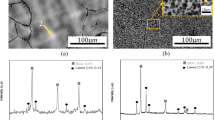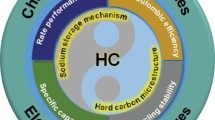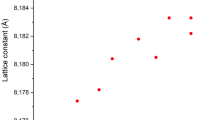Abstract
An alkali metal thermoelectric converter (AMTEC) testing cell was set up, and run with molten sodium-tin (Na-Sn) and sodium-lead (Na-Pb) alloy cathodes. The Na activity, the partial molar enthalpy and partial molar entropy of sodium in molten Na-Sn and Na-Pb alloys have been determined, using a Na concentration cell: Na(1) I beta″-alumina Na-Me(1), where Me= Sn or Pb. The thermodynamic results of these investigations agree with those of other authors. The electric performance of these Na-Me alloy electrodes of different Na concentration and temperatures is described, measuring current-voltage characteristics and a.c. impedance in the AMTEC test cell. The power density of the AMTEC cell with molten alloy cathodes decreases with increasing Na concentration, with the Na concentrations in molten alloys varying from 0.5 to 15 mol%. Maximum power densities of 0.21 to 0.15 W cm−2 at 700°C for Na-Sn molten electrodes, and 0.30 to 0.15 W cm−2 for Na-Pb molten electrodes have been obtained. The a.c. impedance data demonstrated that the molten alloy electrodes have a smaller cell resistance, 0.3–0.35 S2 cm−2 at 700°C after 10–20 h. Comparison with the sputtered thin, porous film electrodes, showed that the contact resistance between electrode and surface of beta″-alumina plays an important role on enhancing cell power density. At 700°C the power density of an AMTEC cell with the molten Na-Pb alloy electrode can be raised to values of about 0.2 W cm eat current densities of 0.8 A cm−2, but at cell voltages not exceeding 0.2V. A model for the theoretical efficiency of the AMTEC cell with molten Na metal electrodes is also presented.
Similar content being viewed by others
References
F. Harbach, R. Knodler and H-P. Bossmann, Physik in unserer Zeit, 1 (1992) 34.
T. K. Hunt, N. Weber and T. Cole, Proc. 13th Intersoc. Energy Conversion Engineering Conference (1978) p. 2011.
T. Cole, Science, 221(4614) (1983) 915.
J. T. Kummer and N. Weber, US Patent 3458356 (1969).
N. Weber, Energy Convers. 14 (1974) 1.
R. M. Williams, M. E. Loveland, B. Jeffries-Nakamura, M.L. Underwood, C. P. Bankston, H. Leduc and J. T. Kummer, J. Electrochern Soc. 137 (1990) 1709.
R. M. Williams, B. Jeffries-Nakamura, M. L. Underwood, C. P. Bankston and J. T. Kummer, J. Electrochem Soc. 137 (1990) 1716.
H-P. Bossmann, Q. Fang, R. Knodler and F. Harbach, ‘Test Cells for the Development of the AMTEC’, 26th. IECEC, Boston, vol. 5, (Aug. 1991) pp. 481–86.
C. P. Bankston, T. Cole, S.K. Khanna and A. P. Thakoor, ‘Alkali Metal Thermoelectric Conversion (AMTEC) for Space Nuclear Power Systems’ in ‘Space Nuclear Power Systems 1984’ (edited by M. S. El-Gentz and M. D. Hoover) Orbit Book Co., Malabar, FL (1985) p. 393.
T. K. Hunt, N. Weber and T. Cole, ‘High Efficiency Thermoelectric Conversion with beta″-Alumina Electrolytes, the Sodium Heat Engine’, in ‘Fast Ionic Transport in Solids’ (edited by J. B. Bates and G. C. Farrington) North-Holland, Amsterdam (1981) p. 263.
R. M. Williams, B. Jeffries-Nakamura, M. L. Underwood, B. L. Wheeler, M. E. Loveland, S. J. Kikkert, J. L. Lamb, T. Cole, J. T. Kummer and C. P. Bankston, J. Electrochem. Soc. 136 (1989) 893.
R. F. Novak, J. R. McBride, T. K. Hunt, D. J. Schmatz, W. B. Copple, N. Arnon and J. T. Brockway, Proc. 23rd Intersoc. Energy Conversion Engineering Conference (1988) p. 219; T. K. Hunt, Proc. 25th Intersoc. Energy Conversion Engineering Conference (1990) p. 420.
Q. Fang, ‘Untersuchungen zur Material- und Betriebstechnik des AMTEC’ PhD thesis, Technische Hochschule, Darmstadt (1993).
Q. Fang and R. Knödler, ‘Porous TiB2-electrodes for the Alkali Metal Thermoelectric Converter (AMTEC)’, J. Mater. Sci. 27 (1992) 6725.
R. Knodler, K. Reiss, B. Westhoven, J. Mater. Sci. Lett. 11 (1992) 343.
R. Knodler, A. Kranzmann, H-P. Bossmann, F. Harbach, ‘Performance of Single Cells of an Alkali Metal Thermoelectric Converter (AMTEC)’, J. Electrochem. Soc. 139 (1992) 3030.
R. C. Weast, ‘Handbook of Chemistry and Physics’, CRC Press, 69th edn, (1988) B99–139
Idem, ibid, F-123.
Idem, ibid, D193.
M. Hansen and K. Anderro, ‘Constitution of Binary Alloys’, McGraw-Hill, New York (1958) p. 999.
R. Hultgren, P. D. Desai, D. T. Hawkins, M. Gleiser and K. K. Kelley, ‘Selected Values of the Thermodynamic Properties of Binary Alloys’, American Society for Metals (1973).
M. Itch and Z. Kozuka, J. Mater. Science 26 (1991) 5221.
IdemM. Itch and Z. Kozuka, J. Electrochem. Soc. 135 (1988) 2238.
Author information
Authors and Affiliations
Rights and permissions
About this article
Cite this article
Fang, Q., Wendt, H. Performance and thermodynamic properties of Na-Sn and Na-Pb molten alloy electrodes for alkali metal thermoelectric converter (AMTEC). J Appl Electrochem 26, 343–352 (1996). https://doi.org/10.1007/BF00242105
Received:
Revised:
Issue Date:
DOI: https://doi.org/10.1007/BF00242105




